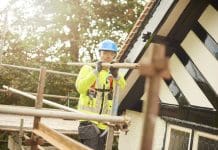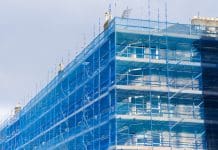Andy Butchers shares his insider advice on the pitfalls you need to know about render products to ensure you get this part of your project right
Render is a popular choice for new homes, extensions and renovations as it can offer a strong, smooth and visually appealing external wall finish. More importantly, when it comes to meeting Building Regulations, using render products typically provides an extra layer of protection against water ingress and can improve a house’s fire rating.
The basics
Traditional render products were formed using lime or clay and designed to absorb water (from rainfall, for example) and release it again over time to protect the main structural fabric of the building. They can still be a good fit for heritage projects but aren’t typically used on new homes.
Cement-based render products became the go-to option in the 20th century, usually consisting of one part water, one part cement and four parts sand. All of these materials are easy to get hold of, so cement render products offered a low-cost option for achieving a smooth, aesthetically pleasing finish. The mix itself was also simple to apply, usually hand-trowelled in thin layers to create a strong, hard result.
One of the downsides of these traditional products was that it could take up to 28 days for the render to dry before it could be painted. What’s more, cheap, older cement-based versions often proved to be inflexible and were therefore prone to cracking.
Updated techniques
Modern methods of construction mean that today, advanced render products are readily available. These can offer vast improvements when it comes to the common problems associated with traditional solutions.
The most notable of these is that drying times have been dramatically reduced, with some ready-mix cement renders needing only 24 hours before finishes can be applied. The advantage of this is twofold: the works can be completed quicker; and there’s less risk of the weather affecting the job, as the timeframe of exposure is greatly decreased.
Modern render products are also available in a wide range of integral colours, negating the need to paint over the top, which can save on labour time and costs. You can also opt for products containing silicone, which provide excellent water-repellent qualities while also improving flexibility (reducing the chances of cracking) and breathability.
You can even spray some renders directly on to base coats or proprietary boards, promoting a much quicker build process.
Metal beading can be used at corners, around doors and windows (stop beads) and when finishing the render above damp proof course (bellcast beading). This can help stop moisture bridging into the fabric of the building.
What to watch out for
Although the latest renders offer a lot of improvements over traditional methods, issues can still arise if they’re not properly specified and applied. Here’s what you need to know:
• Ensure the render you’re using is suitable for the property, location and environment. Traditional options still have their place; a period house may require a lime-based finish that allows the fabric to breathe properly, for instance.
• The render must be compatible with the backing material (such as render boards), which in turn needs to be suitable for the substrate.
• Incorrect backing materials can act as sponges and become saturated with water. Over time, this will allow moisture to enter the cavity behind. On a timber frame building, this could lead to rot taking hold.
• The render products should be properly planned – incorporating movement joints, stop beads and castings – to deflect water away from the fabric and reduce moisture ingress.
• Ensure the system has some form of approval, such as a certificate from the British Board of Agrement. This is often a necessity in order to secure a structural warranty.
• Always use an experienced or specialist contractor who fully understands the product, the building and what you’re trying to achieve – and ensure they apply the render products according to the supplier’s instructions. The majority of warranty claims are due to poor workmanship and design rather than the product. Your manufacturer may run an approved contractor scheme.
More Information
Andy Butchers is a building surveyor with over 25 years’ experience in the construction industry – and regularly shares his knowledge to help self-builders and renovators avoid and overcome issues on their projects. He is a director of Build-Zone Survey Services, which provides technical services for a number of warranty providers. Call 01732 744186 or visit www.bzss.co.uk to find out more.
Build-Zone
6 Pembroke Road
Sevenoaks
TN13 1XR
Tel: 0345 230 9373














